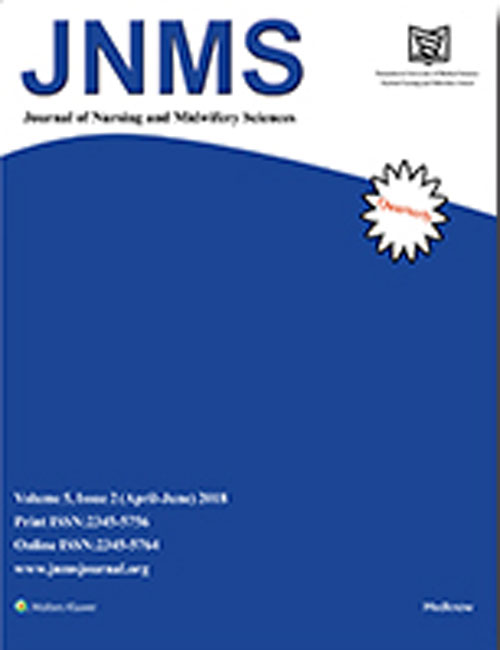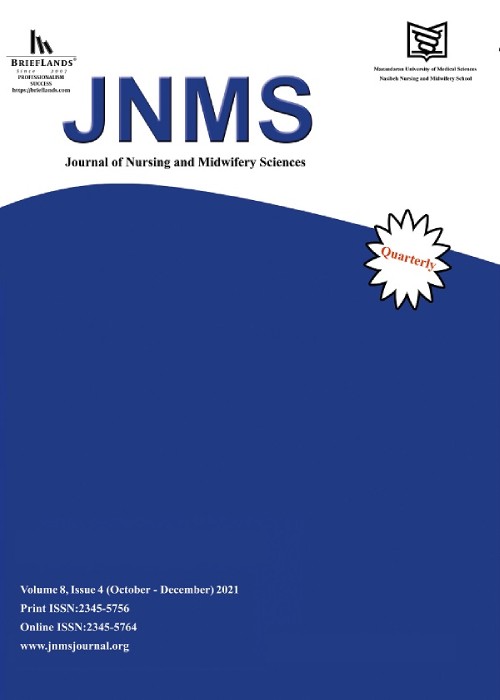فهرست مطالب

Journal of Nursing and Midwifery Sciences
Volume:5 Issue: 2, Apr - Jun 2018
- تاریخ انتشار: 1397/03/31
- تعداد عناوین: 6
-
-
Pages 47-52Context: Persistence of pain will be the cause of the disorder in the process of recovery, sleep, and reduced life quality of patients; therefore, pain management is important in this respect.AimsThis study aimed to compare the nurses' and patients' views about barriers to pain management. Settings and Design: This cross-sectional descriptive-analytic study was conducted in teaching hospitals affiliated to the Shoushtar Faculty of Medical Sciences in 2017.Materials and MethodsThirty nurses from the surgery department were selected by the census method and 150 patients were selected in the quotas. The data collection tool was a researcher-made questionnaire consisting of two sections: demographic information and four areas of barriers (organization, nurse, patient, and physician). Statistical Analysis Used: Data were analyzed using descriptive statistics, Chi-square test, Tukey's test, and t-test using SPSS-16.ResultsThe mean age of the participants (31.3 ± 7.3) and the mean score of the pain management barrier questionnaire were obtained from the patients' view (109.97 ± 16.65) and nurses' view (106.88 ± 13.96). In the nurses' group, there was a significant relationship between work experience and employment status with pain management barriers (P < 0.05). Furthermore, there was no significant difference in the nurses' and patients' view about the pain management barriers (P > 0.05).ConclusionDue to the high percentage of patient-related barriers in the present study, it is essential to recognize these obstacles and to overcome them, and the importance of providing information to patients as part of the management of pain control is emphasized.Keywords: Nurses’, patients’ view, Barriers, Pain management
-
Pages 53-58Context: Today exclusive breastfeeding through the first 6 months of the infant's life has become a challenging issue in the health-care system. It seems the health literacy to be an important element in the women's ability to understanding, processing, and practice on health information.AimsThe aim of this study was determining the relationship between maternal health literacy and their breastfeeding pattern. Setting and Design: This cross-sectional study was conducted in comprehensive health-care centers in Rafsanjan, Iran.Materials and MethodsIn this study, 461 mothers who had 6-month infants and referred to comprehensive health-care centers, from November 2015 to May 2016, were selected by quota and systematic sampling method. The data collection tools were the demographic and standard health literacy for Iranian adults and the breastfeeding pattern questionnaires. Statistical Analysis Used: Data were analyzed using descriptive statistics (mean, standard deviation, and frequency), Chi-square, ANOVA test at a significant level of 0.05.ResultsThe rate of starting breastfeeding in the 1st h after birth was 70.1% and the exclusive breastfeeding rate until 6 months were 68.8%. Health literacy of 5.2% of mothers was inadequate, 71.8% were adequate and excellent. There was no significant statistical relationship between breastfeeding in the early postpartum period and breastfeeding pattern with mothers' health literacy level.ConclusionBreastfeeding pattern of mothers is independent of their health literacy and it seems to take place under the influence of other personal and social-cultural factors.Keywords: Breastfeeding, Exclusive breastfeeding, Health literacy
-
Pages 59-62Context: In Iran, based on the available databases, there were no studies about the quality of work life (QWL) of operating room personnel, and more research that in abroad has been done is focused on the salaries and other benefits and work satisfaction or dissatisfaction.AimsThis study aimed to determine the relationship between QWL and efficiency of operating room personnel of Educational Hospitals of Mazandaran University of Medical Sciences in 2016. Settings and Design: This descriptive-analytical study was done in 2016.Materials and MethodsThe society in this study was all anesthetic and operating room technician personnel working in the operating room of training hospitals of Mazandaran University of Medical Sciences (Sari, Iran). The questionnaire for data gathering was included demographic variables, efficiency, and QWL. Statistical Analysis Used: The data were tabulated and analyzed by means of SPSS 18.0 for Windows (SPSS Inc., Chicago, IL, USA), which was used to calculate descriptive indices, K2-test, and Fisher's exact test.ResultsThe mean age of the participants was 38.67 (standard deviation = 2.98) years. To evaluate the association between QWL and efficiency, Pearson correlation coefficient was used and found a significant relationship between efficiency and QWL of individuals participating in the study (r = 0.48; P < 0.001).ConclusionIt is recommended that managers pay more attention to the QWL for nurses and by adopting suitable strategies of QWL and important component improving the quality of nursing work life.Keywords: Comparison, Efficiency, Operating room, Quality of work life
-
Pages 63-67Context: Endotracheal tube (ETT) cuff pressure should be kept within an optimal range to ensure positive ventilation and prevent the aspiration of oral and gastric contents while maintaining tracheal perfusion.AimsThe aims of the study are to assess the ETT cuff pressure using continuous monitoring. Settings and Design: This cross-sectional descriptive study was conducted on 61 orally intubated patients receiving mechanical ventilation admitted to the intensive care unit's educational therapeutic hospitals in Rasht in the summer of 2013. Material andMethodsThe measurements were carried out using a monitor-connected transducer for 6 h for each unit of study during in two shifts of morning and evening. Variables such as age, sex, diagnosis type, body mass index, and days intubated were investigated. Due to the noninterventional nature of the study, according to the Ethics Committee with registration number 9053, it was not necessary to obtain consent from the patients or their legal guardianship. Statistical Analysis Used: All data obtained was analyzed using descriptive statistics (mean and standard deviation) and inferential statistics (t-test, analysis of variance, and Pearson).ResultsThis study showed that cuff pressure in 90.2% of cases was in normal range (20–30 H2O) and only one person (1.6%) had a pressure of <20 and in 5 (8.2%) higher cuff pressures from 30 cm H2O. The correlation between days intubated (P = 0.01) and body mass index (P = 0.01) with cuff pressure was statistically significant.ConclusionsDuring the 6-h continuous monitoring, the cuff pressure was 9.8% of normal range and this could be a reminder that to prevent complications due to increased or decreased cuff pressure, it may be necessary to have fewer intervals to control the cuff pressure.Keywords: Intensive care units, Intubation, Monitoring, Pressure
-
Pages 68-73Context: In the recent years, unprecedented reduction in fertility occurred in many countries that affected by demographic, economic, social, political, cultural, and familial factors.AimsThe aim of this study is to evaluate studies those determine the correlation between spousal relationship and childbearing. Setting and Design: In this review study, to find both published Persian and English articles, database of Scopus, PubMed/Medline, Google Scholar, Scientific Information Database, and Magiran were searched using keywords of Spousal OR Marital OR Couple AND Relationship AND Childbearing OR Sex Behavior OR Reproductive Behavior that were selected from the MeSH Glossary. There was no limitation about place and study design.Materials and MethodsTwo researchers conducted the electronic search on mentioned databases. The reliability of the data collection method was examined by a third researcher who had good knowledge of the subject but was not aware of the name of journal and the authors. Statistical Analysis Used: No.ResultsOf the 30 studies reviewed, 20 papers directly (increase interaction between spouses increased willingness to childbearing), 9 articles inversely (increase interaction between spouses increased use of contraception and reduced fertility), and one study mutually were shown relationship between spousal relationship and childbearing.ConclusionIt can be said that marital interactions and spousal relationships have a significant correlation with childbearing, and most of the studies mention that there is a direct relationship between them. Fertility growth is impossible without the promotion of individual, social, and familial factors, such as couples' emotional relationships, and policymakers should pay attention to this and plan accordingly.Keywords: Childbearing, Couple relationship, Marital relationship, Reproductive behavior, Sex behavior, Spousal relationship
-
Pages 74-77Statins are medications with great use. One of the side effects of medications is myopathy. In some case, statins switch on, a process of autoimmune system which will not terminate with discontinuation of statins. Necrotizing autoimmune myopathy (NAM) is a subgroup of inflammatory myopathies characterized pathologically by necrotic muscle fibers with absent or minimal inflammation. The purpose of this study was to describe NAM in a patient undergoing treatment with atorvastatin for an extended period, diagnosis of the disease process, treatment, and resolution of symptoms. The case presented in this paper is about 72-year-old woman who showed continued general weakness even though she stopped taking atorvastatin. This patient also had elevated creatine kinase and aldolase. Myopathy confirmed by muscle biopsy. She was treated with intravenous immune globulin (IVIG) and pulse of methyl prednisolone and followed with high dose of steroid and azathioprine. Our case report illustrates the importance of early recognition of NAM and that the treatment with immediately administer IVIG, pulse of methylprednisolone, and high dose of steroid can result in complete recovery.Keywords: Atorvastatin, Autoimmune myopathy, Necrosis


